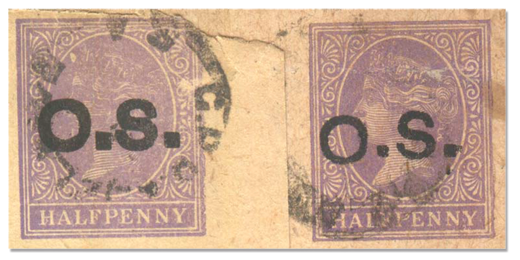“Fly speck” philately is well known to experienced philatelists, especially with regard to stamps issued before 1900. Papers detailing Thirkell-style locations of plate flaws are not uncommon throughout the more serious philatelic literature. There are even careful studies of postal stationery such as air letters and post cards. However, I am not aware of any such published study detailing the printing differences of newspaper wrappers. The purpose of the paper is to stimulate collector awareness about differences between some of the wrappers issued by South Australia. While wrappers have been a neglected area of postal stationery, there are potentially some quite exciting philatelic finds to be made.
The author received a surprise package in the mail that contained a small hoard of South Australian wrappers. The package was sent by the well-known philatelist Hugh Wynn in response to a paper A Survey of Australian Colonies’ Wrappers (Courtis 2004a). Mr Wynn’s generosity in making material available for study is much appreciated, and indeed the analysis which follows would otherwise not have been attempted. The paper examines a selection of wrappers issued by South Australia and reveals what can be discovered with patience and analysis.
There were nine South Australia post office types and seven official issues between 1882 and 1911 (Robson Lowe 1962). Portraits of Queen Victoria are the indicium on each of these issues. The Robson Lowe catalogue listing is confusing because it suggests incorrectly that the ½d green W9 is the Adelaide Post Office. This wrapper is inscribed Commonwealth of Australia and is the same indicium as W8 with colour change from violet to green.
QV 1/2d Purple
Post office issues of South Australia with indicia types 1 and 2 have at least 26 distinguishing differences (see Table 1). While both wrappers have similar wording, coats of arms and purple QV halfpenny side face in oval indicium, a careful comparison reveals many distinguishing variations that have not previously been recorded. The Queen Victoria portraits appearing on these wrappers have no counterpart usage on South Australian adhesives. The inking of the 1882 W1 is of a poor quality and it is difficult to fully identify the nature of the crown jewels and aspects of how the hair has been tied.
| PANEL A: NON-INDICIUM DIFFERENCES | W1 (1882) | W2 (1884) |
| 1. “South Australia” printing length | 3x70mm | 4x67mm & heavier font |
| 3. full stop at end of Australia | Yes | no |
| 4. “Newspaper Only” printing length | 2×46.5mm | 2.5x45mm |
| 5. Bars above/below “Paper/Spaper” | 18.5/17.25mm, bent & broken |
18.5/18.75mm unbroken & stronger |
| 6. full stop at end of Only | Yes or no | no |
| 7. juxtaposition of Y to “STR” of Australia | Y below S | Y below left of R |
| 8. gap between A & indicium | 5.5mm | 6.25mm |
| 9. distance top Arms to lower bar | 21.75mm | 20.5mm |
| 10. horizontal plane drawn across top of South Australia printing cuts indicium | 7mm to top | 4.5mm to top |
| PANEL B: INDICIUM DIFFERENCES | W1 (1882) | W2 (1884) |
| 11. indicium size | 18.5×22.5mm | 18.5×21.75mm |
| 12. white outer border lines overall width | 1mm, thin purple line within | .5mm, thin purple line within |
| 13. frame line lower left | constant plate flaw with bulge in outer frame line | break bottom white inner frame line (not constant flaw) |
| 14. number of corner scrolls | 5 | 6 |
| 15. presence of white dash on left & right sides in middle of scroll work | no | yes |
| 16. length of HALFPENNY | 13.5mm | 15mm |
| 17. white line above of value tablet | line bulges to .5mm | thin .25mm |
| 18. shape of value tablet | angled cuts top left & right | true rectangle |
| 19. incomplete purple line beneath HALFPENNY | pieces of line show copy to copy | no line |
| 20. sideface within oval | 12x15mm oval | 12.5×16.5mm |
| 21. portraits vary especially with different pronunciation around eyes & chin | engraved lines concave curves from mouth to hairline | lips curl in smile & lines more convex |
| 22. lines around portrait | engraved lines run into solid background | white line from crown to chin & 7-lines from base |
| 23. earlobe | looks more like ear | lobe clearly distinguishable |
| 24. base of neck | white wave-like curve | 4 white lines beneath purple line |
| 25. hair pulled | straight, 2 white clasps beneath | wavy & more horizontal, 3 thin diagonal clasps |
| 26. jewels in crown (probably different) | blurred definition, no jewels at hairline | sharp definition of crown & inlaid pearls at hair line |
Table 1: Differences between W1 and W2 South Australian Wrappers
Figure 1 shows the two wrappers with differences 1-10 as per the Table 1 list. The top wrapper is W1. Two quick differentiating techniques are to imagine a vertical line from Y cutting S or R in the line above, and by examining the oval versus circle in the Arms.
Figure 1. W1 and W2 Comparison of Non-Indicium Differences.
The two indicia W1 and W2 are shown in Figure 2 side-by-side at 250% of their original size. The differences 11-26 in Table 1 can be referenced against these scans. Some plate deterioration is apparent in W1 where the lower left corner scrolls appear to join and eventually become a white blob.
Figure 2. Differences 11-25 from analysis of Indicia.
Overprinted O.S.
The Wynn hoard included 11 wrappers and fronts overprinted O.S. on the QV 1884 W2. An analysis reveals that four different types of O.S. were applied and these are shown in Figure 3. These varieties on newspaper wrappers have not previously been noted. O.S. or official stamps were overprinted on South Australian adhesives for general use by a variety of government departments. The standard catalogues list four types, but only the first type without seriffed S appears to have been applied on the newspaper wrappers. The other three types on adhesives were applied between 1891 and 1903.
| Details of Differences | Type I | Type II | Type III | Type IV |
| 1. Distance from left of O to far edge of 2nd square dot | 14.5mm | 14mm | 14mm | 13.5mm |
| 2. Gap between O & S | 2.25mm | 3mm | 2.5mm | 2mm |
| 3. Width of letter O | 5.25mm | 4.75mm | 5mm | 5.25mm |
| 4. Width of letter S | 4.75mm | 4.5mm | 4mm | 4mm |
| 5. Size of square dots | 1.5mm | 1mm | 1.4mm | 1mm |
| 6. Thickness of letters | thick 1.4mm | thin .5mm | 1mm | 1.2mm |
| 7. Shape of tails of letter S | top closed, hairline gap at bottom | .5mm open at top & bottom | .3mm open at top & bottom | top gap hairline, bottom gap .1mm |
| 8. Gap between right edge 1st square dot & S | .5mm | 1mm | .5mm | .5mm |
| 9. Uniqueness of dots | 1st dot raised top left | both raised .75mm from horizontal plane ex O | 2nd sq dot .1mm smaller | 1st dot on plane, 2nd dot .5mm above 2nd dot spur at right |
| 10. Location of S from horizontal plane underneath letter O | on plane | .75mm above | on plane | on plane |
Table 2. Comparison of Four O.S. Types as per Figures 3a & 3b
Because the Adelaide G.P.O. void canceller was used routinely on these types of wrappers it has not been possible to determine their chronological usage from these examples. Types I – IV are arbitrarily assigned such as shown in Figures 3a and 3b.
Figure 3a. Types I and II O.S. Overprint on W2
Figure 3b. Types III and IV O.S. Overprint on W2
Of the 11 examples used for study only one is of Type I. It was this particular overprint that first caught my eye because of its thick letters, the first square dot is raised at the top left, and the tails of the S are almost closed. Ten categories of differences were noted and these are summarised in Table 2. Some of the differences are very subtle and independent confirmation by other collectors is needed. The varieties suggest the possibility of at least four O.S. plates used in the overprinting. However, they could have appeared on the same forme. There are probably more O.S. types waiting to be recorded.
Commonwealth of Australia
Wynn’s hoard included four fronts of the 1911 issue of the Halfpenny QV green. Two matters immediately caught my attention, the opaque horizontal weave straw coloured paper and the white constant plate flaw at 4 o’clock inside the oval frame. This triangular white blob appears on all four copies. A comparison with the 1908 purple Halfpenny QV issue bearing the same Commonwealth inscription revealed a number of differences and these are summarised in Table 3. The wrappers are illustrated in Figure 4, scanned together at their original size. The list of differences in Table 3 can be used to examine the two wrappers.
| Attribute on Wrapper | W7 purple | W8 green |
| 1. “Commonwealth of Australia” length | 2.5x51mm to end of stop | 2.5x56mm to end of stop |
| 2. “South Australia” length | 3.5x72mm to end of stop | 4×72.5mm to end of stop |
| 3. “Newspaper Only” | 2.25x44mm no stop | 2.5×43.5mm with stop |
| 4. Two bars lengths | 16.5/15.5mm | 14/13.5mm |
| 5. Royal Coat of Arms (see Courtis 2004b) | Type 3 oval shield, side-faced lion | Type 1 round shield, lion full face |
| 6. Lettering in South Australia | Seriffed letters, straight bar in H & A, pointed A | Smaller serifs, upward sloping bar in H & A, flat top A |
| 7. Period at end of South Australia | square | dot |
| 8. Gap top Commonwealth to bottom bar | 28.25mm | 28.5mm |
| 9. Gap middle period to indicium |
5mm | 11.5mm |
| 10. Width of wrapper | 159mm | 136mm |
Table 3: Comparison of W7 & W8 QV purple & green commonwealth issues
Figure 4. Commonwealth of Australia 1908 & 1911 issues
Conclusion
Treasure is where you find it! Philatelic discoveries are still to be made, especially with the undeveloped postal stationery field of newspaper wrappers. This paper examined printing differences on South Australian wrappers, namely, a comparison of W1 and W2 QV ½d purple, O.S. overprints on W2, and Commonwealth of Australia W7 and W8. A rigorous study determined 26 differences in the first analysis, and ten each in the second and third. Very few of these “discoveries” have previously been documented.
References
Courtis John K. (2004a), A Survey of Australian Colonies’ Wrappers, Australian Journal of Philately, No. 89, September, pp. 7-31
Courtis John K. (2004b), Differentiating Coat of Arms Types on South Australia Newspaper Wrappers, Postal Stationery Collector, Vol. 10 No. 2 Issue No. 38, August pp. 44-47.












Thanks for sharing such a nice idea, article is good, thats why i have read
it completely
It’s not my first time to pay a visit this site, i am browsing this web page dailly and get fastidious
facts from here daily.